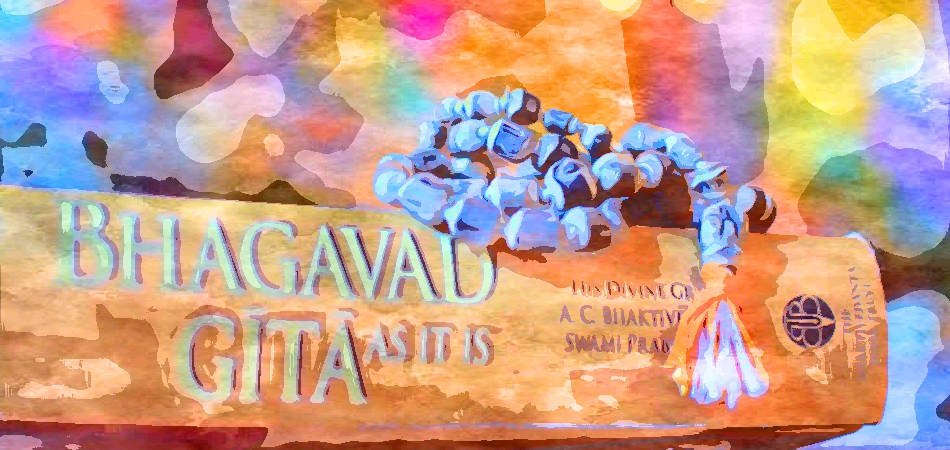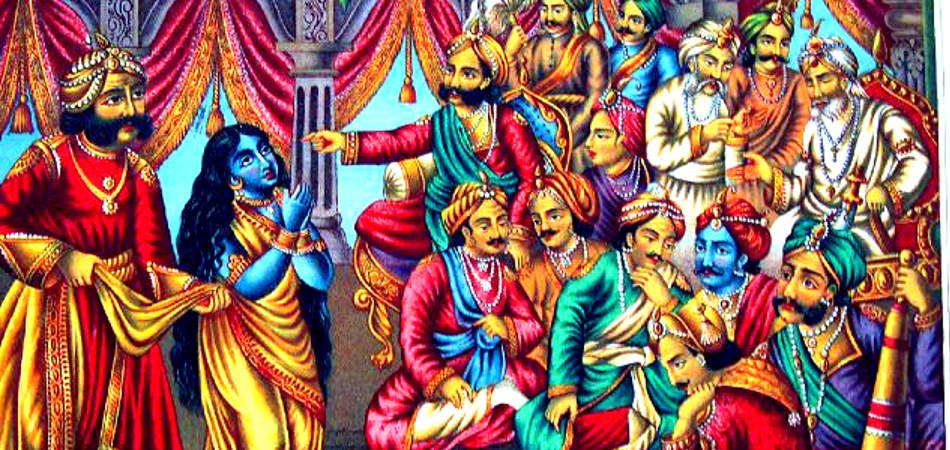What is the meaning of the Yada Yada hi Dharmasya in English?
I remember watching TV Serial Mahabharat, like most of us. However, they rendered this shloka as a song. Listening to the shloka in the form of a song was quite impressive. This shloka is from the sacred Bhagawat Gita. As opposed to what is mistakenly narrated by many people as “Yadha Yadhaya Dharmasya“, the actual narration goes as follows: Yada Yada Hi Dharmasya. Krishna advises Arjuna (also called Partha, Kaunteya, Bhārata…).
Yada Yada hi Dharmasya shloka is the 7th verse of chapter 4. It is easy to understand the literal meaning. In other words, when we directly translate this shloka from Sanskrit to English. Here you go.
The meaning of “Yada Yada hi Dharmasya” sloka in English is:
Whenever, Whenever righteousness (which is the closest word to Dharma in English) declines, when evil arises (perhaps in your mind), Arjuna or anyone else’s mind, then is when I take birth, in your soul (could be body, brain, mind, soul)!

Does it sound confusing? No, not really. Let us divide “Yada Yada hi Dharmasya” shloka into several parts. The complete shloka goes as below:
यदा यदा हि धर्मस्य ग्लानिर्भवति भारत ।
अभ्युत्थानमधर्मस्य तदात्मानं सृजाम्यहम्
Now let us try to find Yada Yada Hi Dharmasya shloka meaning in English by splitting the shloka into several parts.
यदा यदा हि
You notice here that the word Yada is deliberately used twice. This is just to stress the importance of whenever. It could be only whenever (on the trigger of something), not otherwise.
धर्मस्य
If you are an Indian, you would have heard about this word for sure. However, if you are not, there is very little chance that you will have. Even if you would have, to understand its meaning, it could be a Herculean task.
Firstly, there is no one book to refer to in India about Sanatana Dharma. Secondly, there is no one path to Moksha. Thirdly, there is no one god to worship. Therefore, the interactions between human beings have to be measured and built upon something as the basis. This is something that is the basis that could be understood as Dharma.
Dharma in “Yada Yada hi Dharmasya” sloka can be explained better in two contexts. In other words, it can be concerning to society or the individual.
Society:
When it comes to the society, there are many types of dharma. This is mostly for the understanding of one another. For instance, there is;
- Matru Dharma
this Dharma indicates what is the responsibility of a mother. How she should be taking care of the child. Why is she referred to as god etc?
- Pitru Dharma
this Dharma, just like that of the mother, how a father should take care of the family. What should he do in terms of calamity, dangerous situations, etc?
- Acharya Dharma
Acharya Dharma speaks about how should his disciples be mentored. Where he should teach. What a guru has to teach his pupils.
If you observed the above Dharma’s, they are all related. They cannot be followed without considering each other. In other words, Matru Dharma considers the social relationship between the mother and the child. Further, even Pitru Dharma and Acharya Dharma work the same way. There is a mutual connection. This connection is called Social Dharma.
Individual
Here, the stress is given to the individuals, and they are conceptual Dharmas. Following these Dharmas, an individual evolves from a mortal to a greater soul.
As may be said in any language in India:
A human being consistently following the Dharma like how to:
- behave in a certain place
- treat a guest
- treat your mother
- face a battle
- speak with a stranger
Let us analyze this very point further. We shall consider the following shloka that Bhishma advises Yudhishtira, also called Dharmaraj.
Shanti Parva and Bhishma
न राज्यं न च राजाऽसीन्न दण्डयो न च दाण्डिक: |
धर्मेणैव प्रजास्सर्वा रक्षन्ति स्म परस्परम् ||
In conclusion, the above shloka is an outcome of Dharma. In other words, every citizen should follow both the individual as mentioned earlier, and social dharma. As a result,
- firstly, no king is required to rule a kingdom.
- Secondly, there will be no criminal or any crime.
- Lastly, there need not be any judge to penalize the criminal.
People protect each other by the virtue of Dharma. Dharma is quite natural and instills long-lasting happiness in everyone. Though this shloka might look ideal, it is not impossible to follow, at least to a certain extent.
Bhishma tells this to Yudhishtira, also known as Dharmaraj, how good a rule book should be. It should be in favor of every person. Therefore, everyone should enjoy both individually and in society.
Lastly, let us understand this important point that religion is nowhere an equivalent word to Dharma. Religion derives from the word, “Religate“. To relegate means sending to a lower level. In other words, religion means the one that sends us to a lower level. So, this word is inappropriate.
To sum up, this is the kind of Dharma that the shloka is trying to explain to us. That is to say that, when the citizens do not follow Dharma, it is a natural cause of concern.
ग्लानिर्भवति

The declination of Dharma or in other words, Dharma’s dilution. There are so many instances where humans easily compromise on Dharma.
For instance, a teacher might compromise on their teachings, by diluting the syllabus to be covered. This is social dharma compromised. This has an impact on the students, maybe at a later stage when they are not in good positions to handle their work.
Similarly, a father gets addicted to alcohol. This for sure disturbs the whole family. Subsequently, it might traumatize the wife and children, devastating the whole family. What we are talking about might look small, but they are still Adharma.
When Dushyasana, on the order of Duryodhana, disrobed Draupadi, insulting her, the act could be the cheapest act to the core. These could be some instances that show the declination of Dharma.
भारत
Here, in this context, Krishna is referring to Arjuna. Then why is it that he uses Bharata (भारत)? Arjuna is a descendant of Bharata (भरत), the Chandravansh clad, in the lineage. In other words, Bharata (भरत) was the son of Dushyanta and Shakuntala. Bharata (भरत), Dushyanta, etc. were all from the same vansh or lineage, called Chandra Vansh. From Bharata (भरत) comes Bharata (भारत). Therefore Krishna calls him Bharata (भारत).
अभ्युत्थानमधर्मस्य

Adharma is the opposite of Dharma. Most importantly, if we don’t follow dharma, it means that we are on the side of Adharma. More and more of such atrocities prove to give birth to evil. Subsequently, this evil will contribute to a bad society. To sum up, evil actions are a part of our very own ideas.
Ideas take birth in our minds. Our mind is a part of us. In short, the culprit is our mind. Keep this in mind while we try to move ahead to the next phase.
तदात्मानं सृजाम्यहम्
I re-incarnate in your soul. Firstly, I would like to bring to your notice that Sanskrit has several meanings for a single word. For eg., if you consider “amritam“, the first thing that comes to our mind is Nectar. This is of course true. However, one of the other meanings of amritam is also water. Water is called by the following words.
- Aapaha – आपः
- Sthree – स्त्री
- Bhumni – भूम्नि
- Vaarvaari – वारवारी
- Salilam – सलिलं
- Kamalam – कमलं
- Jalam – जलं
- Payaha – पयः
- Keelaalam – कीलालं
- Amritam – अमृतं
- Jeevanam – जीवनं
- Bhuvanam – भुवनं
- Vanam – वनं
If you did not notice, we have marked
Amritam – अमृतं
Being bold from the above list. The list of words is all synonyms of the word water. These and other words are all a part of Amarakosha. Amarakosha is an authentic dictionary of Sanskrit. Words and their synonyms are written in the form of Shlokas. Sanskrit is awesome!
Similarly,
Aatmanam (आत्मानं)
is used in a different context, with a different meaning. In this context it can be any of the following:
- Body – the mortal part of us that everybody first sees about us
- Brain – the logical part of us that makes logical decisions
- Mind – the emotional part of us that makes an emotional decision, connected to the heart
- Soul – the virtual part of us which can also be considered as the collective energy
Reactions are the outcome of our Actions. In this regard, if the part of the action is related to the body, Krishna says, he uses our body as a medium and warns us. It is now, our responsibility to be warned and follow Dharma. However, by not doing so, we might have to face the consequences all by ourselves.
Inference
This shloka is a part of Bhagawat Gita. As part of Yada Yada Hi Dharmasya shloka meaning, Krishna has told us that we are responsible for what we are. If we bring out the godly part that is within us, we will follow dharma.
On the other hand, if we bring out the demon that is within us, we are bound to follow dharma. We should not wait for a god in a form or shape to incarnate and protect us. That will be like saying that we will only sit and wait. We should not stop waiting to protect ourselves from third-party atrocities. If we have to do that, this shloka would be an inspiration.


Excellent – Thank you for sharing.